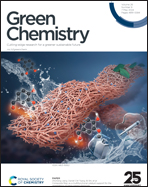High biomass content, anti-flammable and degradable epoxy thermosets by curing a tyramine-derived epoxy monomer with a furan-derived diamine for non-destructively recyclable carbon fiber composite application†
Abstract
Epoxy thermosets are used in many fields because of their outstanding properties. However, commercial epoxy thermosets are flammable, so epoxy resins with excellent flame retardant properties need to be prepared. In recent years, carbon fiber epoxy composites have been widely used in aerospace and other high-tech fields due to their high strength and excellent performance. With the increased use of carbon fiber epoxy composites, the recycling of carbon fibers is an important issue. Herein, a bio-based epoxy vitrimer (TVEP/DFDA) containing a Schiff base structure was successfully prepared by utilizing vanillin, tyramine and furfurylamine. Moreover, carbon fiber epoxy composites (CF-TVEP/DFDA) were successfully prepared. The TVEP/DFDA composite has better mechanical properties than DGEBA/DDM and excellent flame-retardant performance. The limiting oxygen index (LOI) of TVEP/DFDA was 28.5%, and TVEP/DFDA achieved a UL-94 V-0 rating. Heat hazards and smoke hazards are sources of danger in fires. According to the cone calorimetry test, compared with those of DGEBA/DDM, the heat release rate, total heat release and total smoke production of TVEP/DFDA decreased by 73.9%, 52.6% and 56.6%, respectively. The significantly reduced heat and smoke production indicate that TVEP/DFDA has a lower combustion intensity and better fire safety than DGEBA/DDM. CF-TVEP/DFDA also exhibited excellent flame-retardant performance, with a high LOI of up to 45% and a UL-94 V-0 rating. However, the CF-DGEBA/DDM cannot pass the vertical burning test. TVEP/DFDA has excellent stability under different solvents and can be degraded under acidic conditions. This work describes a strategy for recycling carbon fibers by immersion in a hydrochloric acid solution. The recycled carbon fibers exhibit surface morphologies, chemical structures and mechanical properties similar to those of virgin carbon fibers.



 Please wait while we load your content...
Please wait while we load your content...